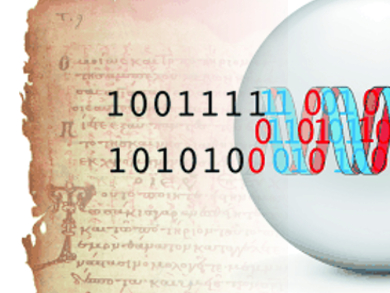Long-Term Storage of Digital Information in DNA
It is evident from samples from mammoths, bears, and other fossils: sequenceable DNA can last up to several hundred thousand years. But one does not necessarily need fossil bones as capsules of silica glass spheres can do the same job, as Robert N. Grass and colleagues from the ETH Zurich demonstrate in their Communication in Angewandte Chemie.
In recent years, there have been several approaches using DNA as a coding language to encode digital information. “However, those approaches are not reliable as they cannot handle errors efficiently and do not suggest how to (physically) store the DNA to maintain its stability over time”, Grass and his colleagues explain. Therefore, they combined an error-correcting coding scheme with chemically embedding the synthesized DNA strands in capsules of silica. Releasing the DNA was performed by simple fluoride chemistry, after which it was sequenced and decoded. “The corresponding experiments show that only by the combination of the two concepts could digital information be recovered from DNA stored at the Global Seed Vault (at –18 °C) after over 1 million years”, the researchers explain.
Silica Glass Spheres Protect DNA
In order to simulate various environmental conditions and to compare different storage technologies, the scientists exposed samples of either pure solid-state DNA, DNA on filter cards, in a biopolymeric matrix, or encapsulated in silica spheres to conditions of elevated temperature (60 – 70 °C) or various humidity levels for a total time of four weeks. Within this time, the state of the DNA was checked in terms of integrity. Encapsulation in silica performed best, and extrapolation revealed that DNA stored by this technology would be sequenced and decoded error-free even after 1 million of years, if stored at temperatures that are found in permafrost.
To demonstrate the applicability of the method to storage of relevant information, the scientists chose two old documents as examples, the Swiss Federal Charter from 1291 and the English translation of the ancient Archimedes Palimpsest on “The Methods of Mechanical Theorems”. Pairs of letters of the text file (or generally two bytes of a digital file, as the authors emphasize) were translated in elements of three to eventually obtain sequences of 158 nucleotides. These nucleotides combine the original information with an index as well as elements of redundancy required for Reed–Solomon error correction. Nature stores genetic information to ensure evolution. Humans store information to pass on knowledge. For storage times as long as one million years, it could be reasonable to use DNA as a storage medium.
- Robust Chemical Preservation of Digital Information on DNA in Silica with Error-Correcting Codes,
Robert N. Grass, Reinhard Heckel, Michela Puddu, Daniela Paunescu, Wendelin J. Stark,
Angew. Chem. Int. Ed. 2015.
DOI: 10.1002/anie.201411378




